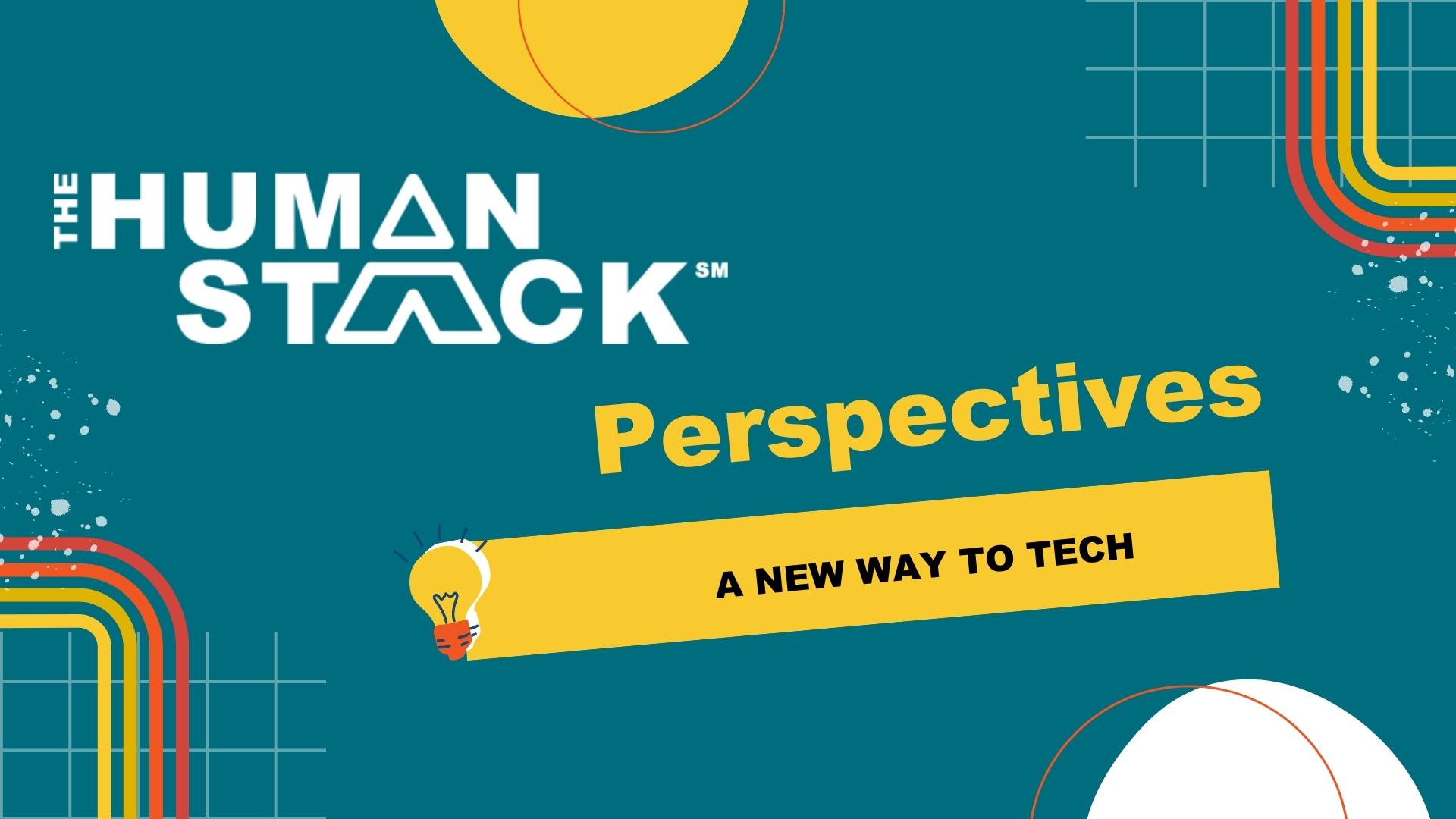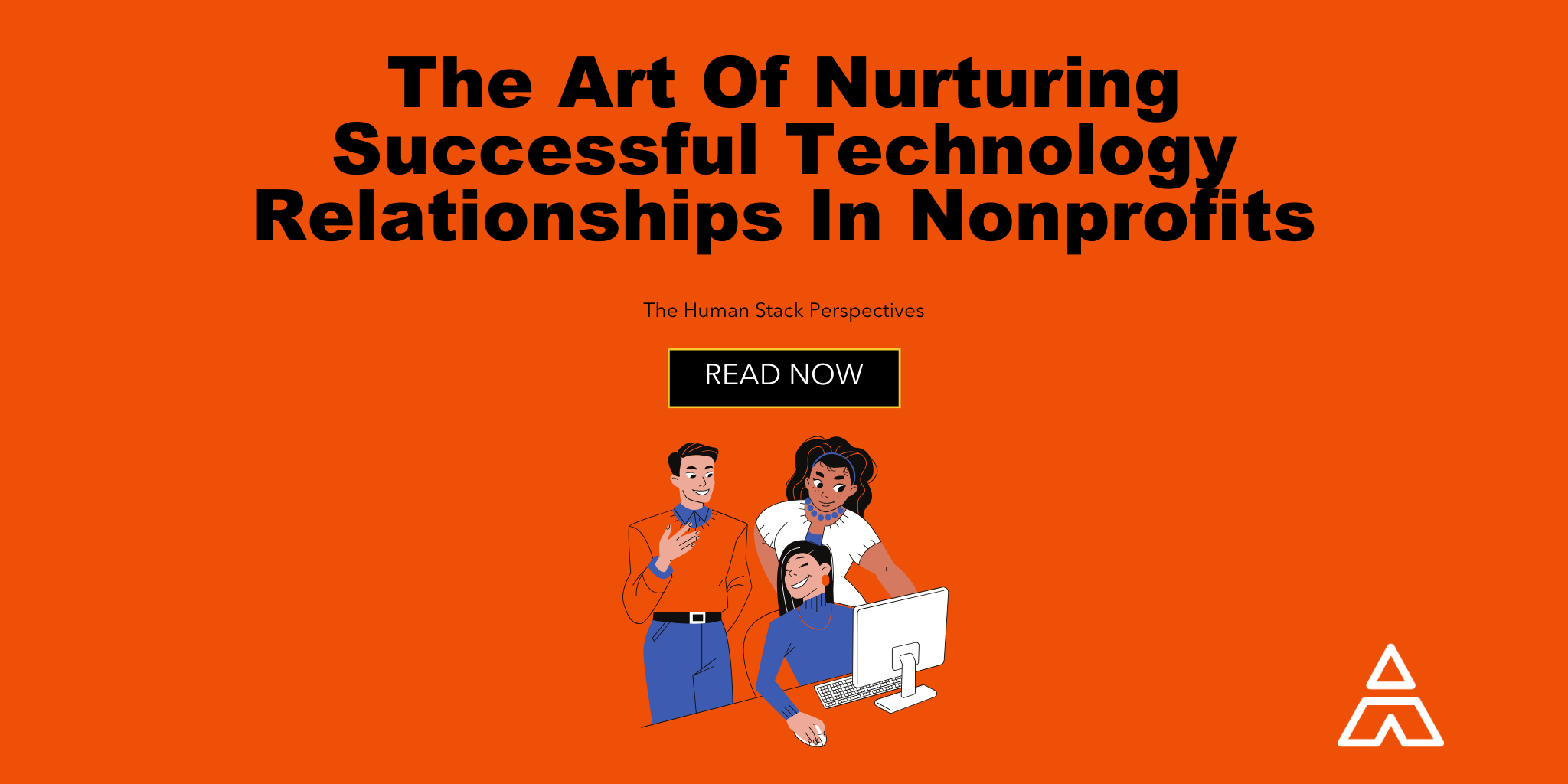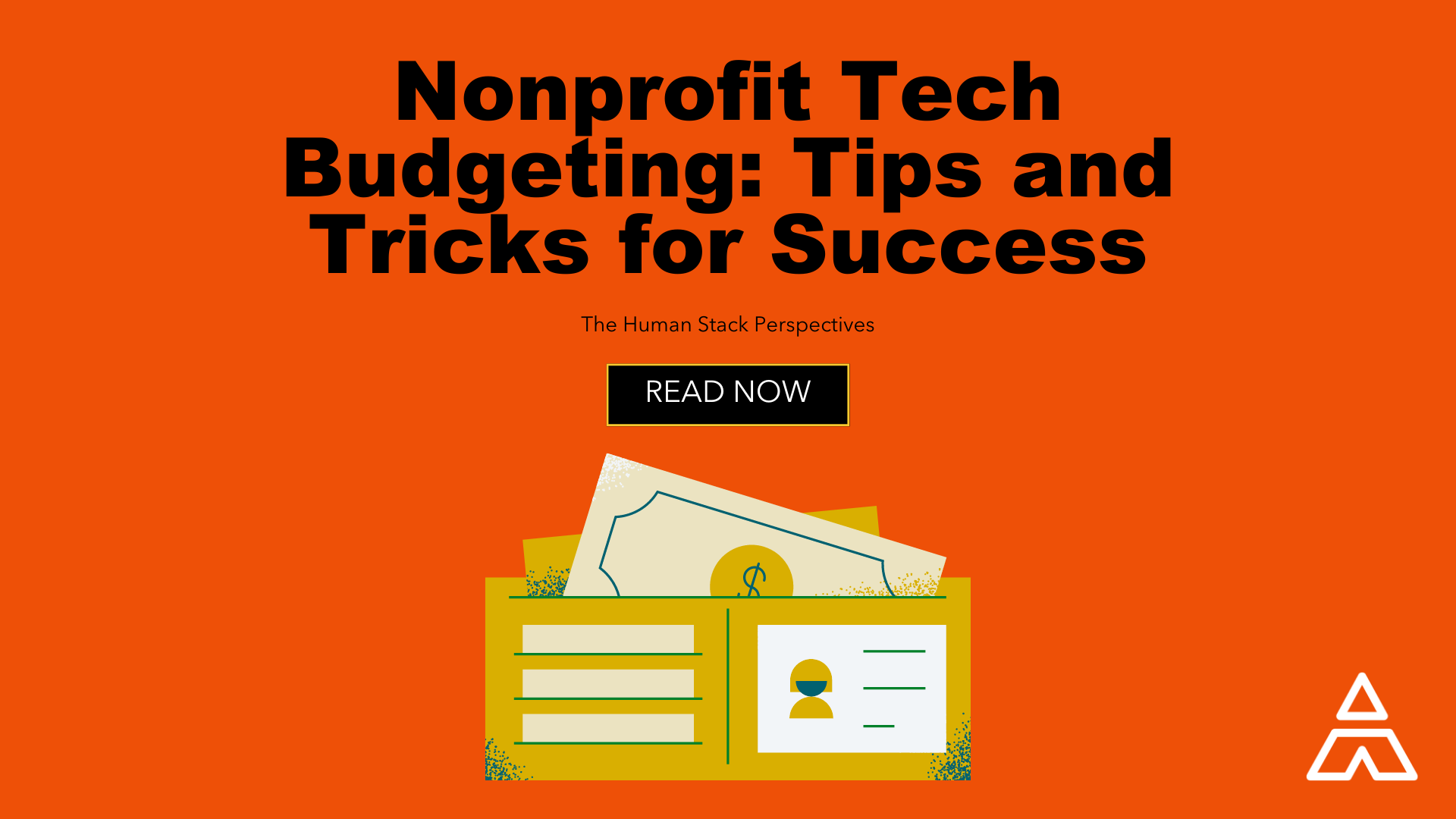12 min read
Six Questions Every Nonprofit Must Ask the Tech Industry in 2021
 Tim Lockie
:
February 2, 2021
Tim Lockie
:
February 2, 2021
Co-Authors: Tracy Kronzak, Director - Innovation, and Tim Lockie - CEO
As we enter into a new calendar year, nonprofits are leaving behind a 2020 that has forced incredibly hard conversations about global equity and justice, access and privilege, and ultimately, how nonprofits act and invest in their operations and constituents. These critical moments require new ways of thinking about where nonprofits spend their dollars on technology, and the outcomes and investments nonprofits should expect in the global impact economy, in return.
In short - nonprofits, globally, deserve the best that technology has to offer. Folks like NTEN have sought to define Tech Equity for nonprofits, and as a technology implementation partner, Now it Matters as a business will be increasingly aligning to SDGs 10 and 17 moving forward. But, the definition of “best” for nonprofit technology is still very much up for debate - there are decades-old discussions regarding what kinds of software pricing and sales drive greater global equity, discussions about implementation methodology, and discussions about nonprofit ownership of their own applications and data via strategies such as common data models and funding applications.
This year, we want to offer a series of key insights every nonprofit CXO should ask when their organization evaluates or invests in technology and platform software. Nonprofit-serving application developers and implementation partners, software providers, and cloud platforms should have clear responses to these that promote choice, alignment, interoperability, and transparency, and the long-term durability of impact economy investments in these commercial business entities’ products and solutions.
#1: How does your solution or platform create choice for nonprofits and competition for nonprofit software solutions?
Why it Matters: Nonprofits ALWAYS benefit from choice in software.
We’ve lived through several iterations of nonprofit-serving software strategies and ecosystems. It’s no secret that Blackbaud's Raiser’s Edge, which originally emerged as an installable DOS program in the 1980s, gained an early and monopolistic lead in serving nonprofits. Frequently, its competitors were acquired, then integrated or discarded, and today, Raiser’s Edge revenue accounts for roughly 30 percent of Blackbaud’s overall sales. Along the way, nonprofit leaders lamented the loss of competing products that were acquired by Blackbaud, such as Kintera, Convio, eTapestry, OrangeLeap, and MicroEdge: all roads led to Blackbaud.
When Salesforce Foundation began offering licenses to nonprofit organizations in the early 2000s, the promise of both a competing product, as well as an emerging ecosystem, drove nonprofits to invest in Salesforce-based solutions. Blackbaud immediately suffered market-share (and reputation) losses because nonprofits could free themselves of Blackbaud’s monoculture, and experiment and innovate on this newly-emerging platform.
Salesforce for nonprofits has had a winding road from Salesforce Foundation, to Salesforce.org as a social enterprise, to its latter-day acquisition by Salesforce.com and integration into the greater commercial entity. It is an industry leader in creating a strong community of loyal customers and administrators who contribute to its product roadmap and the core of what it calls Nonprofit Cloud: the open source Nonprofit Success Pack, now maintained by the nonprofit industry vertical within Salesforce. Salesforce changed the conversation by raising the bar on what to expect from a software platform serving nonprofits.
Just like we would expect any brand to do, Salesforce wants to maximize its position by increasing its product line through acquisitions and product development. There is a concern that this could result in all roads leading to Salesforce. While this isn't unethical, nor is it displaying negative business practices, we do note that the overall effect is an overall decrease in product choice and best-of-breed competition for the sector.
In both these cases, the limitation to nonprofits is that rather than having the space for the ecosystem to innovate for its own self-interest and pick up tools it needs to support this work, the “innovation” is driven mostly by corporate roadmaps in service to shareholders that happen to also offer solutions that work for nonprofits. Along the way, this has the effect of shaping nonprofit business processes to what’s accessible rather than what’s possible in its own right and suits mission-driven ecosystem needs as they emerge.
#2: To what degree is their solution purpose-built to nonprofit business process needs vs. purely commercial software that requires customization or configuration for nonprofits?
Why it Matters: Commercial solutions are helpful, but not complete.
To be abundantly clear, there is nothing inherently wrong with commercial software donating, selling, or otherwise contributing to the nonprofit ecosystem, globally. This is, however, a flag for nonprofits themselves: make these investments with your eyes wide open, and know that mission-driven businesses have different operational priorities for mission-driven reasons. If you’re considering a commercial platform, it’s worth understanding how much configuration is necessary to adapt it to something more aligned to nonprofit operations.
The extent to which commercial software needs shaping, configuration and customization to meet nonprofit operating needs will determine how much money, time, and adoption time your organization will spend on implementation after you sign the dotted line with a platform or solution. The large majority of nonprofits, at least in the United States, adopt a series of point solution technologies because they can’t afford this shaping and time away from their missions. Ultimately, these solutions create drag on organizations when they grow, because data is contained in too many silos, including the old spreadsheet standby. The promise of large platforms is the ease of data integration and transit between systems, and their ability to stretch to meet places inside an organization that a series of point solutions cannot. The downside is that these platforms are first and foremost designed and motivated by corporate use cases, which don’t always cross-translate to nonprofit needs. The most popular nonprofit data platforms from Microsoft, Oracle/Netsuite, and Salesforce all began life as corporate sales and accounting systems.
The aforementioned Nonprofit Success Pack, which substantially tailors Salesforce as a platform towards core nonprofit fundraising needs, is a great example of both successful tailoring of a corporate platform, and corporate investment in the nonprofit ecosystem. It created an industry attention-getting model of leveraging open source, community participation, and business partner support for greater impact, and the legacy of this has been an easy to administer, pre-deployed, and platform-expanding solution used by tens of thousands of nonprofits and impact organizations, globally.
#3: How vested in nonprofits is the team that creates the solution, and does the executive and technical and executive leadership have first-hand experience meeting the needs of the greater nonprofit ecosystem?
Why it Matters: The global nonprofit ecosystem is on a long-term journey to the SDG 2030 goals, and committed resources inside a business serving the ecosystem indicates they are joining nonprofits on this journey. Proven leadership in the sector, as well as nonprofit domain expertise and first-hand experience are foundational to understanding the needs of nonprofits when developing solutions.
Businesses are increasingly incentivized to throw “nonprofit and social impact” add-ons to their suite of industry options without dedicating long term resources and a roadmap. The experience level of the staff that lead these teams matters. Executive leadership sets long term vision navigating business tradeoffs while technical leadership sets priority of key industry feature sets when developing a roadmap. Absence of these qualities frequently abdicates vision and priority to overall commercial drivers in platforms and software that aren’t specifically built for the nonprofit ecosystem.
Just because a business develops and sells software for nonprofits does not always translate to an inherent understanding of the nonprofit ecosystem’s needs inside the same business. There are two different questions here. 1) Are they dedicating resources to a long term strategy? 2) If they have dedicated long term resources, what level of experience do those resources have?
1) Dedicated long term investment. Businesses are beginning to see the value that positive ESG metrics create with customer loyalty and (hopefully) becoming better social and environmental stewards. It’s equally important for nonprofits to look at the long run when evaluating solution options. When service or solutions to nonprofits are put exclusively under corporate marketing, that’s a red flag. It can signal that the business is more interested in telling a good story about “doing good” than it is in developing solutions tailored to their nonprofit customers.
2) First-hand experience of executive and technical leadership. If a business is dedicating long term resources, a second layer of analysis is the experience of the executive and technical leaders developing those solutions. The decisions made about business leadership, investments (philanthropic and political), and sales and development goals, are strongest when they are based on first-hand experience. Leaders with deep domain expertise prioritize mission-driven work, and drive a different set of outcomes for the nonprofit ecosystem and its engagement. Is it a deal-breaker if these leaders are experienced in software development and executive leadership, but don’t have first-hand nonprofit domain experience? No, but it is a sign of what a business thinks is important.
This is, again, an “open eyes,” point for nonprofit leaders to set expectations on the future of a solution or platform. Corporate leadership, product development teams, sales teams, and other key software development drivers with direct experience in the nonprofit ecosystem will have a greater understanding of nonprofit priorities and needs and this will impact their entire organization in software solutions, sales engagement, and product development.
Where that direct experience does not exist, a “voice” for nonprofits will be harder to establish in the operation and priorities of software solutions and platforms.
#4: What is their nonprofit revenue model and what are sales growth goals for this year?
Why it Matters: This gets to the heart of what the expectations are of nonprofit organizations as customers and the relative importance of nonprofits across other industries that are being served.
Sales growth goals can give you a sense of the degree of pressure your account managers (and implementation partners) may be experiencing while working with you; being in the know can give you some pricing information that can help in contracting.
Typical revenue models can treat nonprofit products/services as a charitable, balance nonprofit serving revenue and expenses as net-neutral, or apply a standard growth market approach for businesses - or some combination of these. Now IT Matters, for transparency, has a standard growth market, meaning we grow our business by finding and acquiring new clients. Our sales goal is to grow 17% this year.
We are strong advocates of transparency for businesses serving nonprofits in both revenue model and sales goals. The business revenue/sales models can reveal well-intentioned but unreasonable expectations in providing support and assistance with applications. For example, a donation of product/services for tax deduction may not have enough margin built into the model to create appropriate documentation and customer support for nonprofits. This model works great for smaller applications where the nonprofit-specific customization is extremely minimal, but for more complex applications and platforms, the lack of a robust support for nonprofits becomes a sticking point for end users.
For nonprofit leaders, it’s best not to think of license grants as “donated” - they are a grant. Like all grants, they need attention and consideration. Early on at Now IT Matters we said that Salesforce gives nonprofits a 747, but it doesn’t come with pilots or a flight crew. Know what you are signing up for and dig into the details when evaluating licensing models and support.
You’ll be a more informed consumer if you know the sales goals of software vendors and services providers which can guide your expectations when interacting with account managers from these businesses. Understand that like all salespeople, they are there to help assist in setting expectations, explaining pricing, and following up to keep the contracting process on track. They are not customer support, and will likely not be able to answer your technical questions or solve small issues that come up (though they should help you get pointed in the right direction or point to resources that can help). If sales goals are aggressive, you could end up feeling pressure in contracting without really understanding what you’re getting.
All that is to say, most software providers to nonprofits are for-profit businesses selling to create some form of profit margin. It is admirable that they are pricing differently to nonprofits. This is a good thing because nonprofits need best-in-class software to achieve best-in-world impact.
Finally, we encourage you to ask: What does a commercial business do with sales dollars from nonprofit customers? Are they re-invested in nonprofit organization-specific development and product investments, are they directed to a charitable endeavor, or do they simply add to an overall bottom line for the business? Businesses serving nonprofits should now be able to account, in totality, where nonprofit customer dollars go, and in what proportions, including to overall corporate profit, sales team salaries and bonuses, developer resources, and other areas.
#5: What is the relationship of consulting and application development partners to any large platform ecosystem and how do those partnerships affect their pricing, products, and advising?
Why it Matters: Partnership programs serve an important function in the ecosystem creating trust and experience with larger platforms. Knowing how these partnerships function can give you insight into why certain products and services are recommended.
Many businesses (like Now IT Matters) attach their services or solutions to larger software platforms and join partnership programs. These partner programs are incredibly important in shaping their goals and behaviors when implementing their solutions or implementing on behalf of a larger platform. Partner programs at their best, especially for large software platforms and vendors, help create service efficiency, allow better definition of ecosystem needs, reveal differentiation in service, and form healthy conversations between business partners. Sometimes these partnership programs require or offer financial incentives for selling additional platform/solution components, other times they motivate partners through status and sales attainment. They also usually require an amount of experience, a number of qualified staff, updating their knowledge of the ecosystem, and taking enablement courses. Healthy businesses are committed to the success of their clients, through their service and solution offerings, and evaluate their customers’ success through a number of metrics.
You should feel free to ask vendors and consulting partners if they are part of a partner program and how that program works. Partners should provide transparency around these programs, they are generally good for the ecosystem and can help you sort out which partners are committed and have experience.
Application development partners may be required to pay for API access of a larger platform, and are likely to pass this cost on to nonprofit organizations using their solution, and in some cases larger platforms can dictate exactly how many of these integrated solutions are permitted to exist. At their best, these motivations and partnership programs guide partners into known and best practice solutions. To a less helpful degree, they can motivate the technology and solution options partners feel comfortable presenting to nonprofits. In some worst-case scenarios, partner motivations can dictate that competitive offerings are not presented in the sales cycle because it is not in the financial interest of either a partner business or large platform to do so. What’s best in the market is nonprofits having a set of apps and solutions to choose from and consultants providing background and tradeoffs so that nonprofits are making informed decisions.
Questions you can ask to develop your awareness of vendors you work with:
- Are you a software platform partner and if so, which level are you, with what vendors and platforms?
- What do you need to do to become a partner and maintain a partnership?
- Are there platform driven sales goals that being a business partner are expected to meet? Are they specific to nonprofit sales? What are they?
- How do partners grow their partnership in the ecosystem?
- Does the platform require integration partners to buy in to API access, is that cost reflected in the pricing and service agreements? Will it increase the cost of their development for nonprofits?
- Does the platform even have an API that is accessible outside of its own ecosystem?
#6: How accessible is your data, and does their data platform align to the Nonprofit Common Data Model?
Why it Matters: Nonprofit organizations deserve open access to own their own data, which includes the structures in which their data resides.
There are two issues to be aware of here. The first is how you have access to your data. Yes, there are some platforms and solutions that don’t consider your data yours, or make it challenging to get your data in a usable format (usually a weekly download or a reasonably priced backup app). It’s easy to skip asking this, so take the time in pre-contract and just check it off the list. If the answer to data access is running reports and exporting the results, that’s a red flag. Sometimes there’s a fee to access your data, find that out early and if there are any windows of accessibility (ie. will you have access to the data for any time after your contract expires). What is the definition of data access, and where and when does it apply if you are extracting data from the platform?
The second issue is the ability to exchange data with other systems. This happens on a spectrum from simple to complex, and also free versus paid. When large software platform providers guarantee “interoperability” with their platforms, they frequently ALSO dictate the conditions under which this interoperability can take place (see business partnerships, above, for one example). Business partners can be charged access fees for integrated applications, acquisitions/mergers and internal reorganizations can de-prioritize corporate interoperability goals, and ultimately, dictate the availability of interoperable solutions and strategies. This problem is further complicated when businesses selling to nonprofits don’t have nonprofit domain expertise in their leadership: understanding the frequently nuanced needs of nonprofit data transit is oft overlooked.
We are also excited about community-owned data architecture for nonprofits, into which platforms serving them opt-in to participate. The interdependency of this participation prevents the data architecture itself, and the flow of data between technology platforms from being revoked by the otherwise ordinary operations of any one commercial business. Open source platform solutions and applications are the beginning of the journey, not the end. Entities like the Nonprofit Common Data Model take data ownership to the next logical destination: creating shared data systems that all nonprofits can benefit from without having every application and platform re-invent this wheel.
“Interoperability”, as defined by any given software platform for itself, is not the same as an open data model, nor is it a guarantee that the means by which interoperability is achieved will be something that doesn’t come with additional fiscal or technological investment, such as middleware, integration and/or BI tools. It is the nonprofit community’s ownership, and the participation of platforms and software serving them, that is the important aspect - this takes a technical entity and turns it into an ecosystem-driven, community tool that is then shared for the greater good (assuming the community is prepared to manage and steward it).
We now need a nonprofit industry-specific open source data model, which can inform the framework that supports nonprofit data, and additionally drive discussions in standardizing grantmaking approaches and metrics. Microsoft originally stewarded the Nonprofit Common Data Model (aka, the Nonprofit Accelerator), and it is now becoming adopted across multiple competitor platforms serving nonprofits. We know this sounds idealistic: because it is, but listen to this conversation regarding Oracle/Netsuite’s journey doing exactly this. We believe it’s possible which is why we support the CDM Community.
We care about the ecosystem of nonprofits using technology for social impact which will be enhanced by nonprofits asking these questions and being more informed consumers. Nothing is more vital to a nonprofit than its data, and by centering for-profit businesses on the programmatic needs of nonprofit data first, then creating solutions, the nonprofit ecosystem globally will have a more efficient set of operations that mitigates data migration between platforms, applications, and services. This is a goal that is greater than any one business, and a need unique to nonprofits that is centered on both revenue growth and mission-driven participation.
As we look to the goals articulated in the SDGs to 2030, we see the possibility for a whole-scale evaluation of the inefficiencies, platform infrastructures, and accountability of businesses selling technology to nonprofits and impact economy organizations to ensure the real goals of creating a better world can be met as efficiently and effectively as possible.
The first response has already been shared, who's next?






